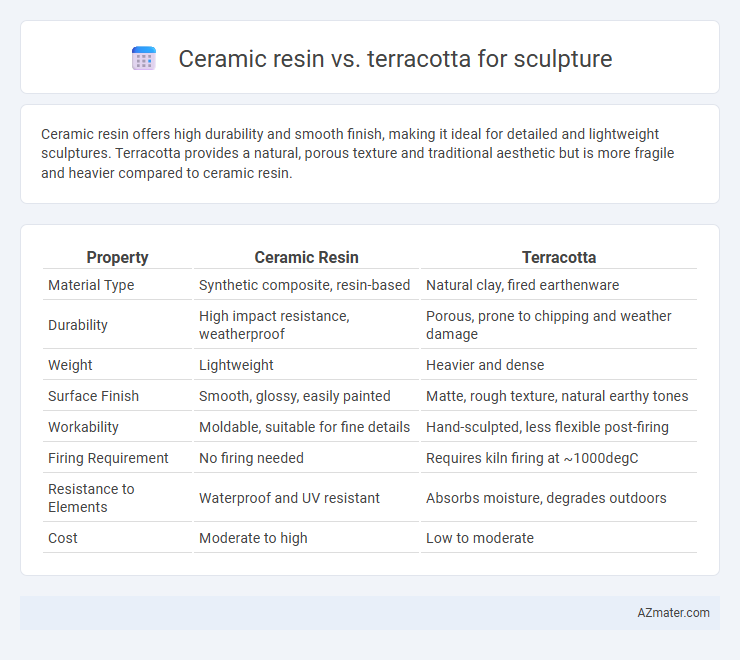Ceramic resin offers high durability and smooth finish, making it ideal for detailed and lightweight sculptures. Terracotta provides a natural, porous texture and traditional aesthetic but is more fragile and heavier compared to ceramic resin.
Table of Comparison
| Property | Ceramic Resin | Terracotta |
|---|---|---|
| Material Type | Synthetic composite, resin-based | Natural clay, fired earthenware |
| Durability | High impact resistance, weatherproof | Porous, prone to chipping and weather damage |
| Weight | Lightweight | Heavier and dense |
| Surface Finish | Smooth, glossy, easily painted | Matte, rough texture, natural earthy tones |
| Workability | Moldable, suitable for fine details | Hand-sculpted, less flexible post-firing |
| Firing Requirement | No firing needed | Requires kiln firing at ~1000degC |
| Resistance to Elements | Waterproof and UV resistant | Absorbs moisture, degrades outdoors |
| Cost | Moderate to high | Low to moderate |
Introduction to Ceramic Resin and Terracotta
Ceramic resin is a composite material combining polymer resins with ceramic powders to create lightweight, durable sculptures with smooth, detailed finishes ideal for intricate designs. Terracotta, a traditional clay-based material, offers natural earthy tones and a porous texture that hardens through kiln-firing, providing a timeless, rustic aesthetic favored in classical and folk art. Both materials serve distinct artistic purposes, with ceramic resin excelling in fine detail and durability, while terracotta emphasizes natural texture and historical authenticity.
Material Composition and Properties
Ceramic resin combines synthetic polymers with ceramic particles, resulting in a lightweight, durable material that offers high resistance to impact and weathering, ideal for modern sculptures requiring fine detail and flexibility. Terracotta, made from natural clay fired at lower temperatures, provides a porous, earthy texture with excellent breathability but is more brittle and prone to chipping under stress. The choice between ceramic resin and terracotta depends on the desired balance between durability, texture, and structural strength in sculptural works.
Historical Usage in Sculpture
Ceramic resin emerged as a modern sculptural material offering durability and flexibility, contrasting with terracotta's ancient popularity dating back to Mesopotamian and Greek civilizations for creating detailed statues and architectural elements. Terracotta's porous, earthy texture allowed for intricate handcrafting, historically favored for both ceremonial and practical sculptures, while ceramic resin gained prominence in contemporary art due to its synthetic resilience and ease of molding. The transition from terracotta to ceramic resin reflects technological advancements influencing sculptural techniques and material longevity through centuries.
Durability and Longevity Comparison
Ceramic resin exhibits superior durability compared to terracotta, as it resists chipping, cracking, and weathering more effectively due to its synthetic polymer composition. Terracotta, made from porous fired clay, is more susceptible to moisture absorption and erosion over time, leading to potential structural weaknesses. For long-term outdoor sculptures, ceramic resin offers enhanced longevity with lower maintenance requirements, while terracotta is better suited for indoor displays where environmental exposure is minimal.
Workability and Sculpting Techniques
Ceramic resin offers superior workability for intricate sculpting due to its smooth texture and flexibility, allowing for fine details and complex shapes to be easily molded. Terracotta, with its natural clay composition, provides a tactile experience and retains moisture longer, which benefits hand-building techniques like pinching, coiling, and slab construction. Sculptors often prefer ceramic resin for precision and longevity, while terracotta excels in traditional, expressive forms requiring gradual drying and firing.
Aesthetic Differences and Finish
Ceramic resin offers a smoother, more uniform surface ideal for intricate details and vibrant, glossy finishes, enhancing contemporary and polished sculptures. Terracotta provides a rustic, earthy texture with matte and naturally porous qualities that emphasize traditional, organic aesthetics. The finish of ceramic resin tends to be more consistent, while terracotta's finish varies, revealing handmade imperfections that add character and warmth.
Weight and Structural Considerations
Ceramic resin sculptures are notably lighter than terracotta counterparts, offering enhanced ease of handling and installation while maintaining durability. Terracotta, composed of natural clay, is significantly heavier and prone to structural fragility, requiring careful support, especially for large or intricate pieces. Resin's lightweight composition allows for thinner walls and more detailed designs without compromising structural integrity, contrasting with terracotta's bulkier, more brittle form.
Suitability for Indoor vs Outdoor Displays
Ceramic resin offers superior durability and weather resistance, making it ideal for outdoor sculptures exposed to varying climates, while terracotta's porous nature suits indoor displays where it avoids moisture damage. Terracotta's earthy aesthetic and breathability enhance indoor environments but require protection from frost and rain when used outdoors. Choosing between ceramic resin and terracotta depends on the sculpture's placement, with ceramic resin excelling in longevity outdoors and terracotta preserving traditional charm indoors.
Cost and Accessibility
Ceramic resin sculptures typically cost more due to the material's advanced formulation and manufacturing process, making it less accessible for hobbyists or small studios. Terracotta, known for its affordability and natural abundance, remains a preferred choice for artists seeking budget-friendly and widely available sculpting material. Accessibility to terracotta clay is enhanced by its ease of sourcing and compatibility with traditional firing methods compared to the specialized production requirements of ceramic resin.
Environmental Impact and Sustainability
Ceramic resin sculptures often involve synthetic materials derived from petrochemicals, leading to higher carbon footprints and challenges in biodegradability compared to terracotta. Terracotta, made from natural clay fired at high temperatures, offers greater environmental sustainability due to its earth-friendly sourcing and potential for recycling or natural decomposition. Artists prioritizing eco-friendly practices tend to favor terracotta for its lower environmental impact and alignment with sustainable art creation.

Infographic: Ceramic resin vs Terracotta for Sculpture
 azmater.com
azmater.com